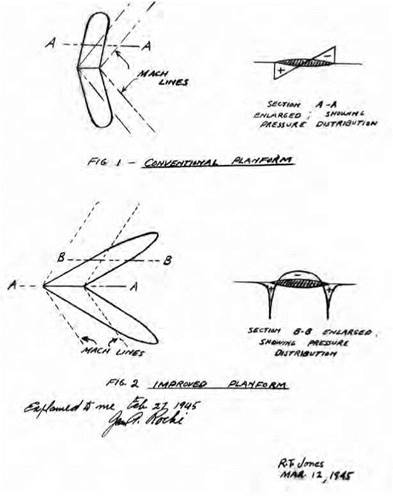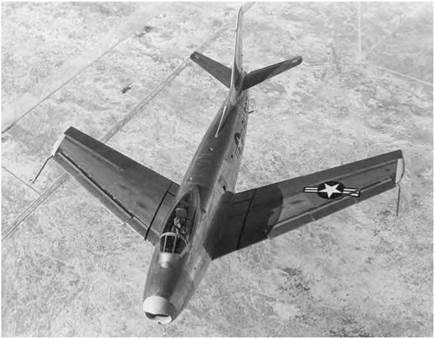Dissemination, Deliberation, and Confirmation
In February 1945, Jones showed his notes on sweep to Jean Roche, the Army Air Forces technical liaison at Langley, and informed others as well, including Maj. Ezra Kotcher of the AAF’s Air Technical Service
Command, and NACA colleagues Arthur Kantrowitz and Hartley A. Soule.[22] Kotcher passed it along to von Karman and Tsien—then working as scientific advisers to Gen. Henry H. "Hap” Arnold, the Army Air Forces’ Chief of Staff—and Soule and Kantrowitz urged Jones to inform the Agency’s Director of Research, George W. Lewis, of his discovery.[23] Accordingly, on March 5, 1945, Jones informed Lewis, "I have recently made a theoretical analysis which indicates that a V-shaped wing travelling point foremost would be less affected by compressibility than other planforms. In fact, if the angle of the V is kept small relative to the Mach angle [the angle of the shockwave], the lift and center of pressure remain the same at speeds both above and below the speed of sound.”[24] Jones subsequently undertook tests in the Langley 9-inch supersonic tunnel of a small, 4-inch-long daggerlike sheet-steel triangular wing with rounded leading edges and a span of only 1.5 inches, tests that complemented other trials at Aberdeen, MD, arranged by von Karman and Tsien.
![]() The Langley tests, through the transonic region and up to Mach 1.75, confirmed his expectations, and Jones published his first test results May 11, 1945, noting, "The lift distribution of a pointed airfoil travelling point-foremost is relatively unaffected by the compressibility of the air below or above the speed of sound.”[25] This was almost 2 weeks before Lippisch informed von Karman, then leading an AAF European study team, of his high-speed delta concepts (during a technical intelligence interrogation at St. Germain, France, on May 23), not quite a month before von Karman assistant Clark Millikan visited the Messerschmitt advanced projects group at Oberammergau on June 9-10 and interrogated Waldemar Voigt about his swept wing fighter concepts, and well over a month before Millikan journeyed to Volkenrode to inter-
The Langley tests, through the transonic region and up to Mach 1.75, confirmed his expectations, and Jones published his first test results May 11, 1945, noting, "The lift distribution of a pointed airfoil travelling point-foremost is relatively unaffected by the compressibility of the air below or above the speed of sound.”[25] This was almost 2 weeks before Lippisch informed von Karman, then leading an AAF European study team, of his high-speed delta concepts (during a technical intelligence interrogation at St. Germain, France, on May 23), not quite a month before von Karman assistant Clark Millikan visited the Messerschmitt advanced projects group at Oberammergau on June 9-10 and interrogated Waldemar Voigt about his swept wing fighter concepts, and well over a month before Millikan journeyed to Volkenrode to inter-
rogate German swept wing inventor Adolf Busemann, on June 20-21.[26]
![]() Langley’s peer reviewers and senior Agency official Theodore Theodorsen did not immediately accept Jones’s assumption that a unified slender wing theory could apply to both compressible and incompressible flows and even questioned the evidence of sweep’s benefits. Fortunately, Jones was greatly assisted in confounding skeptics by the timely results of NACA tunnel tests and falling body experiments, which left little doubt that sweep worked. As well, an associate of Jones made a most helpful discovery: locating a 1942 British translation of Busemann’s 1935 paper. Evidence of an enemy’s interest coincident with one’s own work always heightens its perceived value, and undoubtedly, the Busemann paper, however dated, now strongly bolstered Jones’s case. When it became time to assemble a bibliography for his swept wing report, Jones added Busemann’s paper and other German sources by Albert Betz, H. G. Kussner, Ludwig Prandtl, and Hermann Schlichting, though it is unclear whether this reflected a collegial respect across the chasm of war or simply a shrewd appreciation of their persuasive value.[27]
Langley’s peer reviewers and senior Agency official Theodore Theodorsen did not immediately accept Jones’s assumption that a unified slender wing theory could apply to both compressible and incompressible flows and even questioned the evidence of sweep’s benefits. Fortunately, Jones was greatly assisted in confounding skeptics by the timely results of NACA tunnel tests and falling body experiments, which left little doubt that sweep worked. As well, an associate of Jones made a most helpful discovery: locating a 1942 British translation of Busemann’s 1935 paper. Evidence of an enemy’s interest coincident with one’s own work always heightens its perceived value, and undoubtedly, the Busemann paper, however dated, now strongly bolstered Jones’s case. When it became time to assemble a bibliography for his swept wing report, Jones added Busemann’s paper and other German sources by Albert Betz, H. G. Kussner, Ludwig Prandtl, and Hermann Schlichting, though it is unclear whether this reflected a collegial respect across the chasm of war or simply a shrewd appreciation of their persuasive value.[27]
Langley released his report in late June 1945.[28] In it, Jones noted: "the attachment of plane waves to the airfoil at near-sonic or supersonic speeds (Ackeret theory) may be avoided and the pressure drag may be reduced by the use of planforms in which the angle of sweepback is greater than the Mach angle. The analysis indicates that for aerodynamic efficiency, wings designed for flight at supersonic speeds should be swept back at an
|
Jones showed these notes on the concept of high-speed wing sweep to Langley’s AAF technical liaison representative Jean Roche on February 27, 1945. NASA. |
angle greater than the Mach angle and the angle of sweepback should be such that the component of velocity normal to the leading edge is less than the critical speed of the airfoil sections. This principle may also be applied to wings designed for subsonic speeds near the speed of sound, for which the induced velocities resulting from the thickness might otherwise be sufficiently great to cause shock waves.”[29] Such marked the effective birth of
the high-speed swept wing airplane in the United States, as his report weeks earlier had marked the birth of the American high-speed delta.
![]() By the time Jones’s report appeared, Germany’s aeronautical establishment was already under the microscope of Allied technical intelligence, whose teams swiftly focused on its intensive investment in swept wing aerodynamics for its missiles and aircraft. Replicating reaction to the earlier "discovery” of "Gottingen aerodynamics” after the First World War, the post-Second World War influence of German example and practice was even more profound. Indeed, it affected the entire postwar course of European, Soviet, and American high-speed aerodynamic research, development, test, evaluation, and acquisition. In the increasingly tense national security environment of the burgeoning Cold War, the national intelligence services of the various advanced aeronautical nations understandably maintained very active technical collection efforts to learn what they did not already know.[30]
By the time Jones’s report appeared, Germany’s aeronautical establishment was already under the microscope of Allied technical intelligence, whose teams swiftly focused on its intensive investment in swept wing aerodynamics for its missiles and aircraft. Replicating reaction to the earlier "discovery” of "Gottingen aerodynamics” after the First World War, the post-Second World War influence of German example and practice was even more profound. Indeed, it affected the entire postwar course of European, Soviet, and American high-speed aerodynamic research, development, test, evaluation, and acquisition. In the increasingly tense national security environment of the burgeoning Cold War, the national intelligence services of the various advanced aeronautical nations understandably maintained very active technical collection efforts to learn what they did not already know.[30]
|
The North American XP-86, prototype of the F-86 Sabre family, represented an amalgam of German and American swept wing and streamlined aerodynamics. USAF. |












